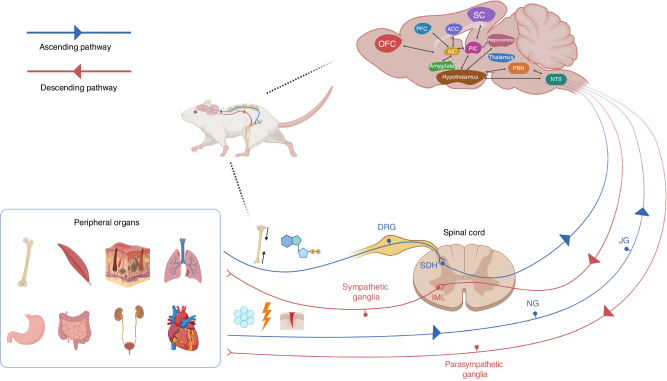Fig. 1.
Diagram of the interoception circuits. The interoceptors located at the peripheral sensory nerve terminals perceive interoceptive signals generated by peripheral organs. The spinal and vagal nerves are two major ascending/afferent pathways that transmit interoceptive signals to the brain. In spinal nerve pathway, the somatosensory neurons in DRG project to the brain via the SDH. The spinal nerves primarily transmit somatic sensations such as temperature, injury, and pain-related signals from the skin, muscle, and skeleton. The vagal nerves transmit mechanical and chemical signals originating from visceral organs through JG and NG. Upon receiving interoceptive signals, various barin regions, including the NTS, thalamus, hypothalamus, PBN, hippocampus, ACC, amygdala, SC, PIC, AIC, PFC, and OFC, partake in the integration and interpretation of these signals. Finally, the brain sends the regulatory signals back the origin organs of interoceptive signals through descending/efferent interoceptive pathways. The SG, receiving projection from preganglionic sympathetic neurons in the spinal IML, and the PSG are two interoceptive effectors to maintain the internal organ homeostasis. This figure is a modified version of Fig. 1 published in Cell Metab Dec 6;34(12):1914-1931. DRG dorsal root ganglia, SDH spinal dorsal horn, JG jugular ganglia, NG nodose ganglia, NTS nucleus tractus solitarius, PBN parabrachial nucleus, ACC anterior cingulate cortex, SC somatosensory cortex, PIC posterior insular cortex, AIC anterior insular cortex, PFC prefrontal cortex, OFC orbitofrontal cortex, SG sympathetic ganglia, IML intermediolateral nucleus, PSG parasympathetic ganglia

